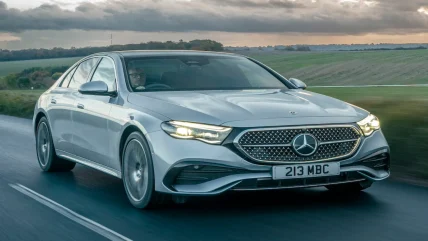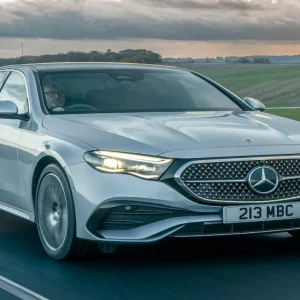
This is the sixth-generation E-Class, whose highlights, according to Mercedes, are a more dynamic exterior, and the latest generation of its MBUX multimedia system, plus all are powered by mild-hybrid or plug-in hybrid engines.
Outside, the influence of the bigger S-Class on the new E-Class’s styling is obvious, with the same high-waisted silhouette, plus pop-out door handles. However, we think the front and rear styling takes its lead from the EV EQ range – especially at the front.
Our car in mid-range AMG Line Premium spec has smooth LED headlights that seamlessly marry with the grille, like a light bar, and its chrome three-point motif design, which is also backlit – just like the BMW i5. There is also a sportier front bumper for AMG Line models. At the back, there’s a high-set light bar, identifiable at night by three-pointed LED lights that look like the logo. The overall look is modern, classy, and subtle, and in our opinion, it’s better looking than the all-electric EQE.
The EQE and EQS show their influence on the inside, with the curvy dashboard design. There is a 12.3in screen perched behind the steering wheel for the instruments, a large 14.4in infotainment touchscreen running the latest MBUX software in the middle, and on our AMG Line Premium car, another 12.3in screen on the passenger side. Although, as we’ve found before when this screen is fitted, it is more of a gimmick than being of any real use. Rear passengers benefit from extra legroom thanks to a 22mm longer wheelbase. The most noticeable interior compromise of having the extra hybrid battery is a drop in boot space (170 litres less than the previous E-Class generation). Although still useful, the boot now totals 370 litres and is practically shaped.
Under the bonnet, the new E-Class is available with the choice of two diesel (E220 d, E400 d 4Matic), and two petrol engines (E200, E450 4Matic), plus of most interest to fleet drivers, an EQ plug-in hybrid that we drive here (E300e). The E300e is powered by a 204hp, 2.0-litre petrol turbo engine, combined with a 95kW electric motor, equalling an impressive 313hp. But the performance figures aren’t what this E-Class is about. Company car drivers are going to be keener on the 8% BIK charge, 35g/km emissions, and up to an unbelievable 565mpg. More impressive is the claimed 70 miles on electric power alone, thanks to a 25.4kWh battery. This is seven miles more than its closest rival, the BMW 530e, can manage. Even in the colder weather when we had this car, the E300e covered roughly 60 miles on EV power, which was a mixture of town and motorway work – and it wasn’t fully charged when we started the trip.
Being the PHEV, this E-Class automatically defaults to electric mode from start off, with the engine only called on at higher speeds or when the battery needs recharging. We didn’t notice much difference in Hybrid mode – the E300e is surprisingly torquey and feels willing from the off – 0-62mph acceleration is completed in 6.4 seconds. This a refined and comfortable way to cover big miles – but the weight of the battery, and the 20in alloy wheels fitted here, give a hard and unsettled ride most of the time, and it is nowhere near as much fun to drive as the latest BMW 530e. Still, at least the steering has a reasonable amount of feel. When it comes to charging, the E300e takes around two hours to fully charge via a wall box, or three hours at an 11kW public charger. The E300e is noticeably nicer to drive when charged, if you can’t go EV, and remains one of the best plug-in choices available.
Mercedes E300e EQ Power AMG Line Premium
P11D: £70,845
Residual value: 42%
Depreciation: £40,440
Fuel: N/A
Service, maintenance and repair: £3,960
Cost per mile: N/A
Fuel consumption: 470.8-565mpg
CO2 (BIK %): 13g/km (5%)
BIK 20/40% a month: £59/£118
Luggage capacity: 370 litres
Engine size/power: 1,999cc/313hp with 25.4kWh battery



